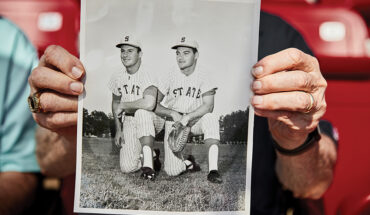
Artist Gayle Lowry, 68, lives in a 1940 Sears Crescent home in Mordecai. “This to me just has more presence and more character (than a new house),” she says. “These houses are solid; they’re substantial. The surfaces are worn, there are bite marks on the windowsills from dogs – life has been lived in this structure long before I was here, and there’s just something nice about that.”
by Mimi Montgomery
photographs by Catherine Nguyen
Most people know the horror of the words “some assembly required”: the miniscule parts and pieces, the half-translated instructions, the ridiculous illustrations that somehow lead you to put the entire thing together backwards. Now imagine that instead of a bookcase or wardrobe, you’re assembling something much greater – your own home.
Such was the case for the families in the first half of the 20th century who purchased and built over 250,000 kit homes in the United States. An outsized number of them ordered and put together their own kit houses here in Raleigh. At least 30 are still standing today, making the City of Oaks a noteworthy Southeastern mecca of kit homes.

Above and below: Anita Watkins, 43, purchased a 1927 Aladdin Plaza home in Mordecai in 2001. She lives there with husband David, 44, sons Owen, 11, and Miles, 8, and dog Jaxby. They were sure to renovate the home in accordance with historic preservation guidelines, and now have four bedrooms, two-and-a-half baths, and a patio they added based on the original Aladdin blueprints. Original flooring, windows, and plaster walls add to the historic charm. “We love it,” says Anita. “We don’t ever want to leave.”
These Raleighites flipped through catalogues of drawings and blueprints, selected the plan that best fit their price range and taste, and had all the materials needed to assemble that home sent right to the curb: doors, cabinets, lumber, shingles – even the kitchen sink.
Nationally, Sears, Montgomery Ward, Aladdin Homes, Gordon Van Tine, and Lewis-Liberty Homes were some of the biggest names in the kit home business. Aladdin and Sears started selling the homes in 1906 and 1908, and the others soon followed suit. In its heyday, Sears sold over 70,000 homes and offered more than 350 blueprints. The advent of industrialization contributed to the homes’ popularity, as it allowed for the mass production of building materials on a wide scale. In turn, this lowered kit home costs for customers, many of whom were members of the growing middle class that wanted their own slice of the American Dream – a well-made family home.

Above and below: Katie and Austin Smith, 27 and 30, knew they wanted a historic home for their first house as newlyweds. In 2014, they purchased a Sears Winona built in 1930 (the first house they viewed), with all “the charm and the character” they wanted, says Katie. The gray house with white trim is complimented by the white-picket fence they added to the front for their dog, Bailey. It’s a two bedroom, one bath, with original molding, floors, a clawfoot bathtub, and a built-in wooden cabinet in the dining room.
These companies made this dream accessible: They provided payment plans, allowed customers to make adjustments in materials as desired, and sent instructions with pre-cut-and-fitted materials. Owners often assembled the houses themselves, piecing each part together, Lego-like, until the home was complete.
Many kit homes were modest, three-bedroom bungalows that reflected the style of the era. Some were more ornate at higher prices; but for the most part, the majority were regular homes for regular people. Consequently, it can be hard to distinguish which are the existing kit homes within a present-day historic neighborhood, as they often look much like the houses beside them.

Above and below: Maria Bleir, 40, her husband Seth, 41, and their children Devin, 8, and Aliya, 6, are one of those young families. They live in a 1927 Sears Elsmore in Five Points. The couple specifically looked for a historic bungalow in Raleigh because they wanted a home with character; that theirs happens to be a kit home is a happy extra. “You don’t get details like this anymore,” says Maria. “All-wood doors, glass knobs on the doors, transom windows – it’s lots of fun.”
It helps to have a trained eye: Rosemary Thornton, a Virginia-based kit home expert and author of The Houses That Sears Built, was in Raleigh visiting her daughter when she spotted an Alhambra Sears home. “When you see one Sears home, you know there are many more,” she says.
She continued to search and was thrilled with what she found: kit homes scattered all over Mordecai, Cameron Park, Boylan Heights, Oakwood, and Five Points.

Briget Horton, 70, has lived in this 1928 Aladdin home in Five Points since 1983. “The Detroit” house had been divided into three apartments when Horton moved in, but she opened it again into one expansive home. An enlarged den, a half-bath, a laundry room, and a relocated kitchen are all additions to the original 1928 floor plan. She says she loves living in a 1920s home in a historic neighborhood – and she’s not the only one. “It’s funny, when I moved in, I was like the young chick on the block,” Horton says. “It was a bunch of old people. Now, it is just flooded with young families.”
Thornton calls it “remarkable” and “a historically significant collection,” with many well-preserved homes featuring a wide range of styles and manufacturers. In 2012, the Raleigh Historic Development Commission and City of Raleigh Museum hosted an exhibit on Raleigh kit homes, and Thornton gave a talk at the Rialto Theatre.
Raleigh’s high number may have something to do with its proximity to an Aladdin Homes mill in Wilmington during the 1920s. These houses tended to catch on quickly – once a neighbor ordered and built a kit home, others followed. It didn’t hurt that the homes were affordable and the economy was healthy. Many of the kit homes in Raleigh were built during this decade of prosperity, when American industry was booming.

This pink 1927 Sears Alhambra home in Five Points is an example of one of the larger kit homes that were available. The layout calls for four bedrooms instead of the standard three, and has additional elements like a solarium.
Of course, this didn’t last: Due to the financial losses of the Great Depression and the increasingly complicated structure of modern homes, kit homes waned in popularity. Sears stopped selling them in 1940, and while some companies continued to offer a small number of the homes, most did not after the mid-century.
Thornton has made it her mission to preserve this segment of American history. They’re worth preserving for more than nostalgia: Their craftsmanship and quality of lumber and materials far surpasses the type typically found today, she says.

A more traditional bungalow, this 1923 Sears Avondale home sits a few blocks away from Oakwood Cemetery. Its original layout consisted of three bedrooms and one bath, making it the perfect starter for a family buying their first home.
But in order to preserve this legacy for the city, these homes need to be maintained, Thornton says. “When you have an old house, you need to get away from thinking of yourself as an owner, and think of yourself as the caretaker. That house is going to be around long after you are.”
Here in Raleigh, that’s the plan.
Want to learn more about kit homes? Check out Rosemary Thornton’s The Houses That Sears Built or visit her webpage at searshomes.org











